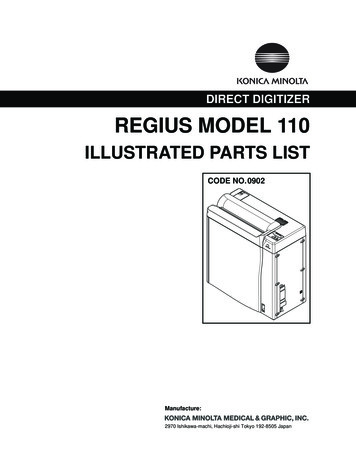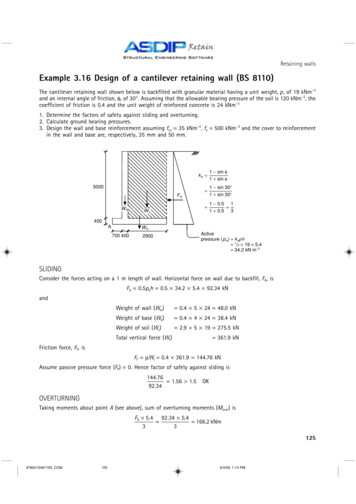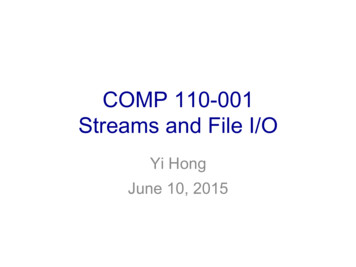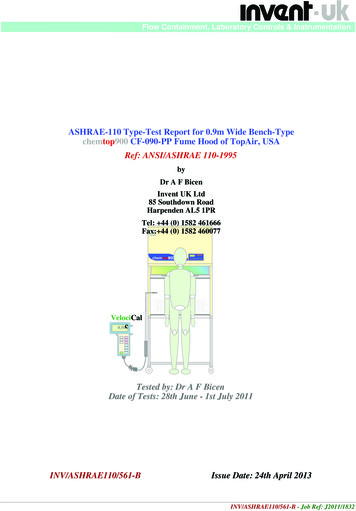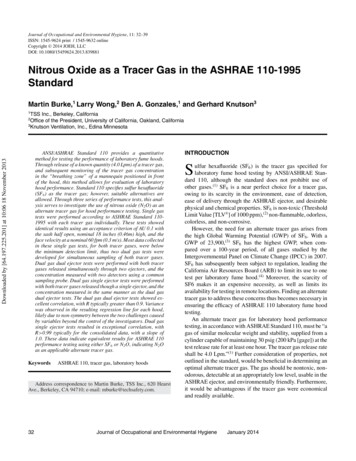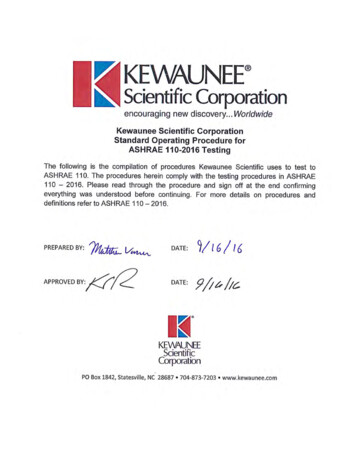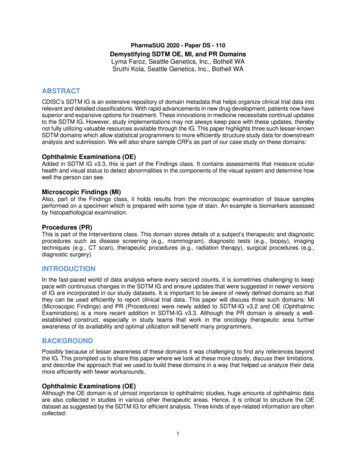
Transcription
PharmaSUG 2020 - Paper DS - 110Demystifying SDTM OE, MI, and PR DomainsLyma Faroz, Seattle Genetics, Inc., Bothell WASruthi Kola, Seattle Genetics, Inc., Bothell WAABSTRACTCDISC’s SDTM IG is an extensive repository of domain metadata that helps organize clinical trial data intorelevant and detailed classifications. With rapid advancements in new drug development, patients now havesuperior and expansive options for treatment. These innovations in medicine necessitate continual updatesto the SDTM IG. However, study implementations may not always keep pace with these updates, therebynot fully utilizing valuable resources available through the IG. This paper highlights three such lesser-knownSDTM domains which allow statistical programmers to more efficiently structure study data for downstreamanalysis and submission. We will also share sample CRFs as part of our case study on these domains:Ophthalmic Examinations (OE)Added in SDTM IG v3.3, this is part of the Findings class. It contains assessments that measure ocularhealth and visual status to detect abnormalities in the components of the visual system and determine howwell the person can see.Microscopic Findings (MI)Also, part of the Findings class, it holds results from the microscopic examination of tissue samplesperformed on a specimen which is prepared with some type of stain. An example is biomarkers assessedby histopathological examination.Procedures (PR)This is part of the Interventions class. This domain stores details of a subject’s therapeutic and diagnosticprocedures such as disease screening (e.g., mammogram), diagnostic tests (e.g., biopsy), imagingtechniques (e.g., CT scan), therapeutic procedures (e.g., radiation therapy), surgical procedures (e.g.,diagnostic surgery).INTRODUCTIONIn the fast-paced world of data analysis where every second counts, it is sometimes challenging to keeppace with continuous changes in the SDTM IG and ensure updates that were suggested in newer versionsof IG are incorporated in our study datasets. It is important to be aware of newly defined domains so thatthey can be used efficiently to report clinical trial data. This paper will discuss three such domains: MI(Microscopic Findings) and PR (Procedures) were newly added to SDTM-IG v3.2 and OE (OphthalmicExaminations) is a more recent addition in SDTM-IG v3.3. Although the PR domain is already a wellestablished construct, especially in study teams that work in the oncology therapeutic area furtherawareness of its availability and optimal utilization will benefit many programmers.BACKGROUNDPossibly because of lesser awareness of these domains it was challenging to find any references beyondthe IG. This prompted us to share this paper where we look at these more closely, discuss their limitations,and describe the approach that we used to build these domains in a way that helped us analyze their datamore efficiently with fewer workarounds.Ophthalmic Examinations (OE)Although the OE domain is of utmost importance to ophthalmic studies, huge amounts of ophthalmic dataare also collected in studies in various other therapeutic areas. Hence, it is critical to structure the OEdataset as suggested by the SDTM IG for efficient analysis. Three kinds of eye-related information are oftencollected:1
1. Any information that is collected by performing eye examinations must be stored in the PE (PhysicalExamination) domain.2. Any eye-related adverse event should be placed in the AE (Adverse Events) domain and utilize the'FOCID' identifier variable to store laterality information ('Left' or 'Right' eye) and link it to the OEdomain.3. If an ophthalmological evaluation is performed, it should be mapped to the OE domain, as it stores asubject’s ocular health and visual status.Microscopic Findings (MI)This domain was originally a part of the IG for the Standard for Exchange of Non-clinical Data (SENDIG)and later was added to SDTM-IG v3.2 in section 6.3 of the Findings General Observation Class. Becauseinformation that can be incorporated in this domain may seemingly lend itself to be mapped to the LBdomain as well, a careful evaluation should occur to determine where to map such ambiguous information.We will see what kind of data can be placed in this domain in the following section.Procedures (PR)Oncology studies collect myriad data to assess the safety profile of a study drug including medical history,adverse events, concomitant medications, prior systemic therapy, prior radiation therapy, prior surgicaltreatment, etc. Information from prior systemic therapy, prior radiation therapy, and prior surgical treatmentCRFs sometimes gets mapped into the CM (concomitant medication) domain. This approach isunderstandable, as the SDTM IG does describe the CM domain as "CRF data that captures the concomitantand prior medication/therapies used by the subject." However, after the addition of the PR domain inSDTM-IG v3.2, its use should be encouraged, and an understanding of this domain should be sharedamongst peers and colleagues.There are three scenarios for which a procedures domain can be used.1. To map various procedures/therapies directly in PR domain instead of presenting them in CMdomain.2. If a measurement is collected due to a specific procedure, then those results should be stored in therespective findings domain and a record for the procedure should be created in the PR domain. Forexample, if a biopsy is performed of a tissue sample and histopathological results are obtained, thenthe biopsy procedure can be mapped to the PR domain and the corresponding result can be mappedto the MI domain.3. Sometimes information about a test method is collected in the --METHOD variable of a findingsdomain. This test method may also qualify as a procedure; examples are an MRI or CT scan. SDTMIG v3.2 suggests capturing records in the PR domain if information such as start and end date orduration of the test is collected along with indicator variables such as PROCCUR (Occurrence),PRPRESP (Pre-specified), PRSTAT (Completion Status), and PRREASND (Reason Not Done). Ifonly findings information is collected, then the decision lies with the sponsor whether to representthat procedure in the PR domain as it is optional to do so.OPHTHALMIC EXAMINATIONS (OE): STRUCTURE AND IMPLEMENTATIONThe OE domain is a Findings domain used for tests that measure a person's ocular health and visual status.It includes tests of visual acuity, color vision, ocular comfort (e.g., dryness, itching), intraocular pressure,etc. The purpose of the OE domain is to collect physiological ophthalmic examinations and thecorresponding results only. When specialized ophthalmic examinations are performed in a trial, use the OEdomain to map the data collected during these examinations. If eye examinations are performed as a partof general physical examinations, then it should be mapped to the PE domain rather than OE. Any datapertaining to morphological ophthalmic examinations should be mapped into the MO (Morphology) domainand not to OE.2
Data Set StructureOE has one record per ophthalmic finding per method per location, per time point per visit per subject. Touniquely identify each ophthalmic record, a new Identifier variable named FOCID (Focus of Study-specificInterest) was introduced as part of SDTM OE. It is used as a key identifier variable to store information suchas right eye (oculus dexter: FOCID OD), left eye (oculus sinister: FOCID OS) and both eyes (oculusuterque: FOCID OU).Location variables (--LOC, --LAT, --DIR, --PORTOT) are permissible in the OE domain since thisinformation may or may not be collected on a trial.Although there is a potential duplication of information by having FOCID and --LOC/--LAT as permissiblevariables, populating these variables with any available data is still helpful in data aggregation and grouping.SDTM ImplementationAs a case study, this paper uses a sample CRF page that consists of assessments to be performed torecord the results.The assessments performed are: Visual AcuitySchirmer’s TestSplit LampIntraocular pressureFundoscopyOphthalmology diagnosisWas an ophthalmology exam performed?YesNo [SUPPOE]Date of ophthalmology exam (DD/MMM/YYYY)[OEDTC]Visual AcuityVisual Acuity Right Eye (OD)Normal[FOCID ’OD’] [OELOC ’EYE’] [OELAT ’RIGHT’]Abnormal[OETESTCD ‘VANAOD’]Not Done[OEORRES]Visual Acuity Left Eye (OS)Normal[FOCID ’OS’] [OELOC ’EYE’] [OELAT ’LEFT’]Abnormal[OETESTCD ‘VANAOS’]Not Done[OEORRES]Vision changes since last evaluationYes[OETESTCD ‘VSCHG]NoNot Applicable[OEORRES]Schirmer’s Test3
Schirmer’s Test Right Eye (OD)Normal[FOCID ’OD’] [OELOC ’EYE’] [OELAT ’RIGHT’]Abnormal[OETESTCD ‘SCHTOD’]Not Done[OEORRES]Schirmer’s Test Left Eye (OS)Normal[FOCID ’OS’] [OELOC ’EYE’] [OELAT LEFT’]Abnormal[OETESTCD ‘SCHTOS’]Not Done[OEORRES]Table 1. Sample CRF for Visual Acuity and Schirmer’s TestThis example shows a general anterior segment examination performed on each eye at one visit, with thepurpose of evaluating general abnormalities.In Table 2 Below, assessments are performed for the left and right eye at each visit. FOCID of OS identifiesthe records pertaining to the left eye while FOCID of OD identifies the records for the right eye. The variablesOELOC and OELAT also help in aggregating the records.Table 2. SDTM OE Data for a Subject with Assessments for Schirmer’s Test and Visual Acuity (Leftand Right)All the assessments performed are collected as a test (OETEST/OETESTCD).The grouping qualifier variable --CAT is used to indicate the function corresponding to the object of the testand --SCAT is used for further sub-classification, if available.In our current sample, CRF OECAT would be populated with Visual Acuity, Schirmer’s Test, Split Lamp,Intraocular pressure and Fundoscopy.OESCAT may be populated with, for example, High Contrast or Low Contrast if such further qualificationsare collected.MICROSCOPIC FINDINGS (MI): STRUCTURE AND IMPLEMENTATIONThis domain was originally a part of SENDIG and later was added to SDTM-IG v3.2 in Section 6.3 of theFindings General Observation Class. This domain model provides a record for each microscopic findingobserved. It contains results from the microscopic examination of tissue samples performed on a specimenwhich is prepared with some type of stain. For example, any histologic or histopathological examination,such as the immunohistochemistry IHC method which treats a tissue with a stain that adheres to veryspecific substances, and its results should be stored in the MI domain. Special attention should be given totests that could also be mapped to other domains such as LB. For example, examination of cells in fluidspecimens should be mapped to LB if the fluid specimen is blood or urine.Data Set StructureThe MI domain follows the data structure of one record per finding per specimen per subject. Importantvariables taken from SDTM-IG v3.2 are shown in Table 3.MITESTCDMicroscopic Examination Short Name4
MITESTMicroscopic Examination NameMITSTDTLMicroscopic Examination DetailThis variable is new in SDTM-IG v3.2 and implemented in the MI domain for the first time. Itprovides further details to the test performed, such as reaction score, intensity score orpercentage of specific proteins (e.g., biomarkers of interest) present on the tissue sample,etc.MIRESCATResult CategoryCategorize the result, such as if the finding is 'malignant' or 'benign'MISPECSpecimen Material TypeKind of specimen used for performing the test. Examples include 'tissue’, ‘bone marrow',etc.MISPCCND Specimen ConditionSpecimen created by performing any specific methods, example: 'AUTOLYZED'MIMETHOD Method of Test or ExaminationTechnique used, or type of stain used for slides. For example: IHC (immunohistochemistry).Table 3. List of Important variables in the MI DomainSDTM ImplementationWe’ll present a case study of a biomarker of interest named Tissue Factor (TF), a transmembraneglycoprotein that is expressed in larger amounts during oncological transformation on the membranes ofneoplastic cells and tumor- associated endothelial cells. In order to understand the relationship betweenthis biomarker protein and cancer indication, a tumor tissue sample was collected. The IHC(immunohistochemistry) method was used to stain the tissue sample and results were reported for stainingintensity of cytoplasm and membrane that ranged from 0 to 3 . The percentage of cells for each intensitylevel was reported and used to calculate an H-score ranging from 0 to 300. This information could havebeen easily been understood to map to the LB domain, as the dataset is received along with other labparameters. However, while referring to SDTM-IG v3.2, it became apparent that this kind of data had anentire domain that could be used.Table 4. Presenting the Mapped SDTM MI Data per SDTM-IG v3.2The intensity level was assessed in the cytoplasm. Since this information is important and cannot be placedin any available variable in the MI domain, it can be stored in the SUPPMI domain and represented inQNAM as CELLOC (Cellular Location).Table 5. SUPPMI5
PROCEDURES DOMAIN (PR): STRUCTURE AND IMPLEMENTATIONThe Procedures domain belongs to the interventions class which stores collected data about a subject'stherapeutic and diagnostic procedures. Any procedure-related data except measurements or results,whether therapeutic or diagnostic, can be stored in this domain. Careful consideration should be given tomeasurements or results collected from a procedure: these should be stored in the appropriate findingsdomain. SDTM-IG v3.2 gives some example procedures which are:1. Disease screening (e.g., mammogram, pap smear)2. Endoscopic examinations (e.g., arthroscopy, diagnostic colonoscopy, therapeutic colonoscopy,diagnostic laparoscopy, therapeutic laparoscopy)3. Diagnostic tests (e.g., amniocentesis, biopsy, catherization, cutaneous oximetry, finger stick,fluorophotometry, imaging techniques (e.g., DXA scan, CT scan, MRI), phlebotomy, pulmonaryfunction test, skin test, stress test, tympanometry)4. Therapeutic procedures (e.g., ablation therapy, catheterization, cryotherapy, mechanical ventilation,phototherapy, radiation therapy/radiotherapy, thermotherapy)5. Surgical procedures (e.g., curative surgery, diagnostic surgery, palliative surgery, therapeuticsurgery, prophylactic surgery, resection, stenting, hysterectomy, tubal ligation, implantation)Data Set StructureThe data structure of PR is one record per recorded procedure per occurrence per subject. A list ofimportant variables taken from the SDTM-IG v3.2 are shown in Table 6.PRLNKIDLink IDThis variable can be used to link relationship between records or relationship betweenPR and another findings domain if the measurement for a procedure is represented insuch other domainsPRTRTReported Name of ProcedurePRDECODStandardized Procedure NamePRPRESPPre-specifiedPROCCUROccurrenceThis variable is populated if pre-specified (PRPRESP) has a value of 'Y'When ADaM endpoints that look for the absence of a given procedure are designed, it istempting to look for PROCCUR N. However, PROCCUR is used only when there arepre-specified procedures, hence looking for PROCCUR N often yields incorrect resultsas there will be no such records in SDTM for subjects who said on the CRF they didn'thave the procedure. Thus, the correct strategy for such endpoints is to look for theabsence of an SDTM record with that specific test, rather than the presence of a recordwith PROCCUR Y.Table 6. List of Important Variables in the PR DomainSDTM ImplementationExample 1:Information regarding prior surgical treatment, prior radiation therapy, and prior systemic therapy wascollected for a patient before enrollment. Two example CRFs of surgical treatment and radiotherapy are asfollows,Prior Surgical Treatment [PRCAT]Has the patient had surgical treatment for thiscancer?[NOT SUBMITTED]YesNoDescription of surgery[PRTRT]6
Site of surgery[PRSITE in SUPPPR]Primary tumorMetastatic site for palliative/symptommanagementDate of surgery (DD/MMM/YYYY)[PRSTDTC] [PRENDTC]Prior Radiation Therapy [PRCAT] [PRTRT 'Radiotherapy']Has the patient had any prior radiotherapy for thisYescancer?No[NOT SUBMITTED]Site of radiation[PRSITE in SUPPPR]Primary tumorMetastatic site for diastinumLungLiverCNS-whole brainCNS-localizedBoneLymph nodeOtherIf other, please specify [PRLOCOTH in SUPPPR]Date therapy started (DD/MMM/YYYY)[PRSTDTC]Date therapy stopped (DD/MMM/YYYY)[PRENDTC]Table 7. Sample CRF for Prior Surgical Treatment and Prior Radiation TherapyTable 8. SDTM PR Domain for a Subject With Prior Surgical Treatment and Radiation TherapyExample 2:For cases where procedure information is collected along with measurements/results, a PR record iscreated for the performed procedure and the corresponding measurement is represented in a findingsdomain. Table 9 below shows a biopsy procedure represented in the PR domain and Table 10 shows thecorresponding histopathological measurements performed by immunohistochemistry in the MI domain.Records for both data sets are placed in the RELREC domain linked with an identifier variable such asPRLINKID from PR and MILINKID from MI.Table 9. PR DatasetTable 10. MI Dataset With IHC Results for a Tissue Sample Collected via a Biopsy Procedure7
Table 11. RELREC Dataset Showing the Link Between PR and MICONCLUSIONUtilizing SDTM-IG v3.2 and v3.3 to design these databases helps to create SDTM datasets efficiently andmakes the review process easy by clear traceability. Awareness of these newly added domains in SDTMIG v3.2 and v3.3 along with an understanding of when and how to use them especially for data that could,at first glance, deceivingly lend itself to be mapped into other more established domains will benefit higherquality SDTM production and submission.REFERENCESCDISC Study Data Tabulation Model (SDTM) v1.4, Study Data Tabulation Model ImplementationGuide (SDTMIG) v3.2 & dtmAlyssa Wittle, Christine McNichol, Antonio Cardozo, 2016. “Moving up! – SDTM v 3.2 – What isnew and how to use it” PharmaSUG l#DSFred Wood, Diane Wold, Rhonda Faile, Wayne Kubick, 2014. “Data Standards Development forTherapeutic Areas: A Focus on SDTM-Based ngs.html#DSMarcelina Hungria. “Ophthalmic Examinations (OE) Domain Overview and DGMENTSWe would like to acknowledge our manager Shefalica Chand and John Shaik for inspiring us to contributeto PharmaSUG and for their constant support.CONTACT INFORMATIONYour comments and questions are valued and encouraged.Contact the authors at:Lyma FarozSeattle Genetics, Inc.21823 - 30th Drive S.E.Bothell, WA 98021lfaroz@seagen.comSruthi KolaSeattle Genetics, Inc.21823 - 30th Drive S.E.Bothell, WA 98021srukola@seagen.com8
domain to map the data collected during these examinations. If eye examinations are performed as a part of general physical examinations, then it should be mapped to PE domain rather than OE. Any data the pertaining to morphological ophthalmic examinations should be mapped into t

